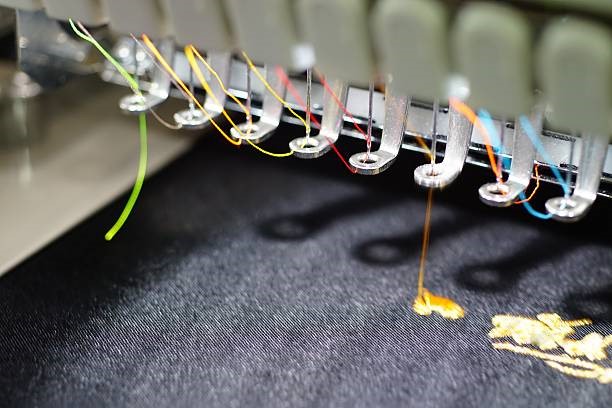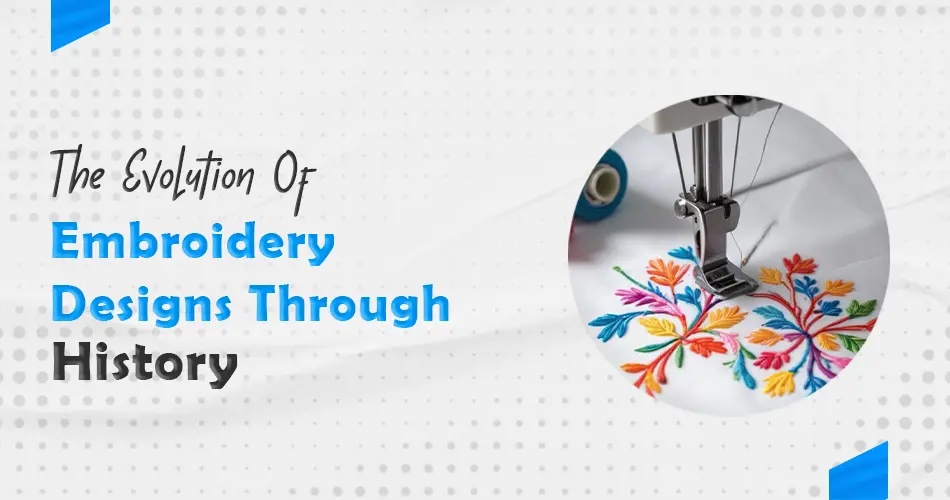Introduction of embroidery designs
Embroidery has been a form of decorative art for centuries, with origins dating back to the 5th century BC. BC. However, it took until the middle Ages for embroidery patterns to emerge and develop into the intricate and beautiful patterns we know today. From traditional hand-embroidered patterns to modern digital designs, the evolution of embroidery designs has been a fascinating journey influenced by different cultures, styles and techniques. In this blog post we take a closer look at the history of embroidery patterns and how they have evolved over time.
The ancient beginnings of embroidery designs
If we travel back in time, we find the origins of embroidery patterns in ancient civilizations. Imagine the early days of China, when elegant, embroidered robes draped the kings and every stitch illustrated stories of bravery and wisdom. Now imagine ancient Egypt, where tunics and burial garments, richly decorated with embroidery, played a central role in their cultural activity. This intricate craft went beyond aesthetics, it was a means to document myths, weave religious narratives, and capture the beauty of nature. Here, embroidery wasn’t just a skill; It was an ancient tradition, a way of storytelling, a cultural guardian.
As we delve into the past, we discover that these designs were not merely decorative in nature, but reflected a rich historical narrative woven from threads and stitches. The ancient beginnings of embroidery offer a vibrant panorama of color and story, showing us that our ancestors used the canvas of fabric to tell stories and preserve their heritage. The threads used in these early designs were not just materials, but connections to our past, interweaving history, culture and art.
Middle Ages and the development of religious embroidery
In the middle Ages, embroidery found a new purpose and direction. As Christianity had a profound influence across Europe, the church became the main sponsor of this intricate craft. The sacred area began to dictate the themes of embroidery, leading to the birth of religious embroidery. Church vestments, altar cloths, and tapestries were beautifully decorated with intricate embroidery that told stories of Scripture and saints, all captured in thread and stitch.
An iconic masterpiece from this period is the Bayeux Tapestry. This embroidered cloth is not just a work of art, but a woven chronicle of a pivotal historical event. Through fine engravings it tells the story of the Norman Conquest of England, making it a significant historical artifact.
This period marked a major change in the use of embroidery patterns. Moving from mere decoration, it became a medium to reflect religious narratives and teachings. Every stitch and design became a testimony of faith and devotion. With religious embroidery, the middle Ages gave this ancient craft a spiritual dimension, making each thread a sacred verse in the fabric of time.
Embroidery in the East: A History of Complexity and Color
While the West was steeped in religious embroidery, the East wove a different story, full of complexity and color. A key hallmark of this region’s embroideries was the vibrant color palette and exceptional detail. For example, Chinese artisans developed a special technique known as “silk embroidery.” These patterns were so intricately embroidered and full of life that they were often compared to elaborate paintings. At the same time, “Zari embroidery” emerged in India, known for its textile heritage. This elaborate technique used lustrous gold and silver threads to weave exquisite designs on royal clothing and furnishings. The splendor of these Eastern designs reflected not only their cultural affluence but also their appreciation for elaborate artistry. Thus, the embroidery of the East painted a vivid picture of opulence, complexity and cultural wealth and wove a vibrant tapestry of regional craftsmanship.
The Renaissance Era and the Birth of Personal Embroidery
In the luminous dawn of the Renaissance, personal embroidery came into being. The societal shift of the era democratized this skilled craft, taking it from the realm of the church and the royal court, and placing it into the hands of common folk. This was a time when people began to embroider their own attire and everyday items with unique personal designs. Monograms, heraldic family crests, and intricate floral patterns began to flourish on garments and linens, reflecting the individuals’ identity and personal taste.
This was a distinct transition from the storytelling embroidery of old, with a new emphasis on decorative aesthetics and stylized abstraction. Embroidery designs in this epoch echoed the artistic spirit of the Renaissance, characterized by creative liberation and humanistic values. While the monastic scribe of the middle Ages had used illuminated manuscripts to create an individual testament of faith, now the skilled embroiderer was able to make their personal mark on their everyday world. The Renaissance served as a catalyst, transforming embroidery from an illustrative narrative medium to a vibrant form of personal expression. The embroidery of this period indeed mirrors the renaissance in thinking that was sweeping Europe, opening new horizons for this ancient craft.
Industrial Revolution and the Introduction of Machine Embroidery
The dawn of the Industrial Revolution ushered in a new era for embroidery designs, sparking an unexpected evolution. With the advent of embroidery machines, this craft stepped off its traditional, handcrafted pedestal into a bustling, mechanized world. In the blink of an eye, patterns once painstakingly stitched by hand could be replicated en masse, making embroidery more accessible and affordable. This transformative period undoubtedly shifted the dynamics of embroidery, signaling the beginning of large-scale production and commercialization. However, it was not without its sacrifices. Some traditional techniques were inevitably lost in the transition, replaced by the efficiency and speed of mechanized production.
Yet, this new chapter in embroidery’s history also opened doors to exciting design possibilities, as artists now had the opportunity to experiment with unique, intricate patterns that may have been too complex or time-consuming to produce by hand. The Industrial Revolution, therefore, left an indelible mark on the evolution of embroidery designs, intertwining the threads of tradition with the gears of innovation. With every machine-stitched design, it continues to remind us of the fascinating blend of history, art, and technology that constitutes the world of embroidery.
Modern Embroidery Designs: A Blend of Tradition and Innovation
In our contemporary world, embroidery designs beautifully fuse the old and the new. These designs are like vibrant bridges connecting the meticulous handcrafting of ancient artisans, the narrative-rich designs of medieval times, the elaborate color play of Eastern creations, and the unique personal touch imbued during the Renaissance. Leveraging the power of digital tools, today’s embroidery artists blend tradition and innovation in their creations, effortlessly pushing the boundaries of this timeless art form.
These modern designs reflect our collective history and individual stories, while also infusing new perspectives and inventive techniques. This duality brings a dynamic quality to embroidery, making it a vibrant, living art form. The artist’s needle today does not merely stitch threads; it weaves together past, present, and future, creating designs that are as diverse and unique as our shared human experience. As we marvel at the embroidery of today, we are invited to appreciate this beautiful amalgamation of ancestral craftsmanship, personal creativity, and technological advancement. And with each modern creation, we witness how the evolution of embroidery designs continues to echo the rhythm of our evolving society, harmonizing the threads of tradition with the pulse of innovation.

Conclusion
Embroidery designs, an intriguing fusion of art, culture, and history, are far more than just patterns on fabric. They serve as a timeline of human civilization, tracing our journey from the ancient epochs to the modern era. With each stitch, they narrate tales of royal grandeur, religious devotion, artistic revolution, and technological innovation.
As we explore modern designs, we’re invited to appreciate the blend of ancestral skill, personal expression, and cutting-edge technology. With the promise of continued growth and exploration, embroidery designs are set to traverse further, weaving more colorful and exciting chapters into the fabric of their ever-evolving narrative. Ultimately, embroidery designs are timeless storytellers, bridging eras and cultures, and echoing the rhythm of our evolving society. They stand as testaments to our shared human experience, harmoniously intertwining the threads of tradition with the pulse of innovation.




